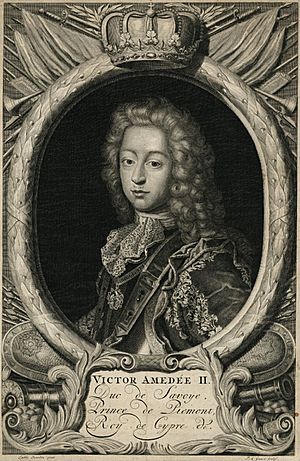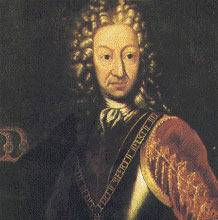Victor Amadeus II facts for kids
Quick facts for kids Victor Amadeus II |
|||||
|---|---|---|---|---|---|
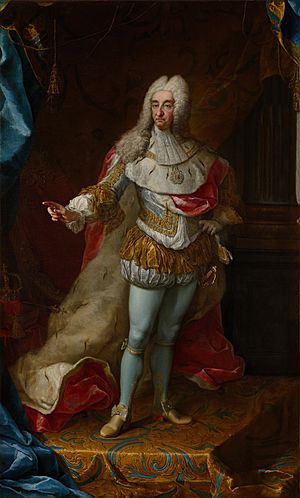
Portrait by Martin van Meytens (1728, Palace of Venaria)
|
|||||
| King of Sardinia | |||||
| Reign | 17 February 1720 – 3 September 1730 | ||||
| Predecessor | Charles VI, Holy Roman Emperor | ||||
| Successor | Charles Emmanuel III | ||||
| King of Sicily | |||||
| Reign | 22 September 1713 – 17 February 1720 | ||||
| Coronation | 24 December 1713 | ||||
| Predecessor | Philip IV | ||||
| Successor | Charles IV | ||||
| Duke of Savoy | |||||
| Reign | 12 June 1675 – 3 September 1730 | ||||
| Predecessor | Charles Emmanuel II | ||||
| Successor | Charles Emmanuel III | ||||
| Regent | Marie Jeanne (until 1684) | ||||
| Born | 14 May 1666 Royal Palace, Turin, Savoy |
||||
| Died | 31 October 1732 (aged 66) Castle of Rivoli, Turin, Savoy |
||||
| Burial | Basilica of Superga, Turin, Italy | ||||
| Spouse |
Anna Canalis di Cumiana
(m. 1730) |
||||
| Issue Detail |
Maria Adélaïde, Dauphine of France Maria Luisa, Queen of Spain Victor Amadeus, Prince of Piedmont Charles Emmanuel III, King of Sardinia illegitimate: Maria Vittoria, Princess of Carignano Vittorio Francesco, Marquis of Susa |
||||
|
|||||
| House | Savoy | ||||
| Father | Charles Emmanuel II, Duke of Savoy | ||||
| Mother | Marie Jeanne Baptiste of Nemours | ||||
| Religion | Roman Catholicism | ||||
Victor Amadeus II (born May 14, 1666 – died October 31, 1732) was an important ruler from the House of Savoy. He led the Savoyard states from 1675 to 1730. He was the first person in his family to become a king. First, he ruled as King of Sicily from 1713 to 1720. Then, he became King of Sardinia from 1720 to 1730. He also held other titles, like Duke of Savoy and Prince of Piedmont.
Louis XIV of France arranged Victor Amadeus's marriage to keep France's power in Savoy. But Victor Amadeus soon wanted to be free from French influence. When his father died in 1675, his mother, Marie Jeanne Baptiste of Savoy-Nemours, became the regent. She ruled for her nine-year-old son. She stayed in power until 1684, when Victor Amadeus took full control. After fighting in the War of the Spanish Succession, he was given the Kingdom of Sicily in 1713. However, he had to trade it for the smaller Kingdom of Sardinia in 1720.
Victor Amadeus made many cultural changes in Turin. He updated the Royal Palace of Turin and the Palace of Venaria. He also built the Basilica of Superga, where he is buried.
Contents
Early Life and His Mother's Rule
Victor Amadeus was born in Turin. His parents were Charles Emmanuel II, Duke of Savoy and his second wife, Marie Jeanne Baptiste of Savoy-Nemours. He was named after his grandfather, Victor Amadeus I, Duke of Savoy. He was their only child. As a baby, he was called the Prince of Piedmont. This was the usual title for the future ruler of Savoy. He was a weak child, so his health was watched very carefully. Even as a young boy, he loved soldiers and was known for being very smart.
His father died in June 1675 in Turin. He was forty years old. Victor Amadeus's mother became the Regent of Savoy. She was known as Madame Royale at court. In 1677, she tried to arrange a marriage for Victor Amadeus. She wanted him to marry his cousin, Infanta Isabel Luísa of Portugal. His mother wanted this marriage because it would have made her stay in charge of Savoy. Victor Amadeus would have had to live in Portugal. But Victor Amadeus refused to marry her. The marriage was canceled even after a contract was signed.
Other possible brides included Maria Antonia of Austria and Anna Maria Luisa de' Medici. Victor Amadeus liked the idea of marrying someone from Tuscany. But that marriage never happened. Finally, Louis XIV and his mother made Victor Amadeus marry a French princess. She was Anne Marie d'Orléans. His mother wanted this marriage because she was French and always supported French interests. In 1684, Victor Amadeus asked for Anne Marie's hand. He had been working with political friends to end his mother's power. He succeeded in 1684, and she was no longer involved in ruling the state.
The Salt Wars: A Challenge to Power
A big event during his mother's rule was the Salt Wars in 1680. These were rebellions caused by unpopular taxes on salt. This tax system had been in place for over 100 years. It was meant to raise money for the government. People were very unhappy about the annual tax. A rebellion started in Mondovì. People there refused to pay taxes. An army was sent to stop the unrest, and the town quickly calmed down.
However, in the town of Montaldo, the unrest started again. This time it was more serious. About 200 soldiers were killed in fighting that lasted several days. News of these rebellions spread. It became clear that all of Piedmont was close to a revolt. Victor Amadeus's mother was still in power. She ordered representatives from Mondovì to come to Turin. The young Victor Amadeus welcomed them. He agreed to new treaties. This event allowed Victor Amadeus to show some of his own power.
Becoming Duke of Savoy
After taking power from his mother, Victor Amadeus prepared for his marriage. He was marrying Anne Marie d'Orléans. She was the youngest child of Philippe I, Duke of Orléans, who was the brother of Louis XIV. Their marriage contract was signed in Versailles on April 9. Anne Marie was married by proxy on April 10, 1684. This means someone stood in for Victor Amadeus. The couple married in person on May 6, 1684.
Dealing with the Vaudois Protestants
In 1685, Louis XIV pushed Victor Amadeus II to persecute the Vaudois. These were Protestants living in Piedmont and Savoy. The state was already low on money because of wars and a famine in 1679. Because Victor Amadeus later made alliances with England and the Dutch Republic during the Nine Years' War, he had to stop this persecution by 1688. In 1694, he even issued an Edict of Toleration. However, in 1698, Louis XIV forced him to make all Protestant immigrants leave Savoy. This was part of a treaty from 1696.
During this time, Victor Amadeus wanted to be free from Louis XIV's control. His first sign of independence was a visit to Venice in 1687. There, he met with Prince Eugene of Savoy and others. Louis XIV found out and demanded that Victor Amadeus attack the Vaudois again. He did so unwillingly. But as you'll see, he soon chose allies who were against France.
Changes and Improvements in Savoy
Victor Amadeus II made many big changes to how Savoy was run. In 1696, he created a system of intendants. These officials were like French ones. They were in charge of collecting taxes and enforcing laws. In 1697, he started a land survey called the Perequazione. This survey looked at land ownership and special rights of the Church and nobles. It was mostly finished by 1711. In 1717, he changed the government offices in Turin. He created separate secretaries for war, internal affairs, and foreign affairs. From the 1670s, he also built a new government area in Turin. This area included a military academy, a war ministry, a mint, and a customs house. This work was still going on when he died.
Victor Amadeus also made many changes to the military. If one of his important forts was attacked, he would replace its commander. He would put one of his most trusted leaders in charge. In 1690, he created a special militia in his lands. Later, in 1714, he completely changed the militia system. He made strict rules for it. This included making each region provide a certain number of men for the militia based on its population. From 1713, he also started to build his own navy. This was based on the small navy he got from Sicily.
Victor Amadeus used his experienced armies from foreign wars to gain more control within his own lands. When Mondovì rebelled again, he brought veteran soldiers from the Nine Years War. He quickly re-established his authority. He used a similar plan against a tax riot in Cigliano in 1724.
Savoy's Role in European Wars
When Victor Amadeus's mother was regent, Savoy was very close to France. It depended heavily on France, even though it was part of the Holy Roman Empire. Victor Amadeus II broke this connection. He joined alliances against France in both the Nine Years' War and the War of the Spanish Succession. Savoy was a valuable ally in these wars. This was because of its location, which allowed a new front against France in the south. Savoy relied a lot on money from other countries, especially England and the Dutch Republic, to pay for its armies in both wars.
The Nine Years War
At the start of the Nine Years War, Savoy had three groups of soldiers helping France in Flanders. Victor Amadeus worked hard to get these troops back for his own use. Part of his agreement with the Grand Alliance against France was that they would help him get back Pinerolo. His ancestor, Victor Amadeus I, Duke of Savoy, had lost this area decades before. In 1692, he was the only member of the Grand Alliance to fight on French land. He invaded the Dauphiné. In 1695 and 1696, he secretly made a separate peace treaty with Louis XIV of France. This treaty included Pinerolo being returned to Savoy. During the war, he greatly increased the size of Savoy's army. It grew from about 8,500 soldiers to more than 24,000.
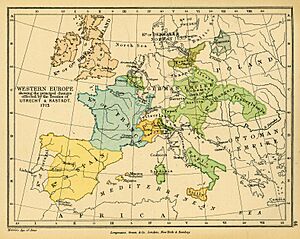
The War of the Spanish Succession
During the War of the Spanish Succession, money from other countries made up almost half of Savoy's war budget. The end of the Nine Years' War had created a new balance of power in Europe. When Charles II of Spain died without children, he left his throne to Philip. Philip was the grandson of Louis XIV. Victor Amadeus was also in line to become king of Spain. He was a great-grandson of Infanta Catherine Michaela of Spain. Because of this, Victor Amadeus expected to gain some land from the large Spanish empire. He wanted the Duchy of Milan. He had signed a treaty with Louis XIV to help him conquer it. But Louis XIV's support lessened. So, Victor Amadeus then allied himself with Emperor Leopold I.
England and Austria ignored Victor Amadeus's claim to the Spanish throne. Austria had its own candidate, Archduke Charles. He immediately declared himself King of Spain. The Grand Duke of Tuscany also ignored Victor Amadeus's claims. Meanwhile, Victor Amadeus worked to expand Savoy. He bought several small territories from the Holy Roman Empire.
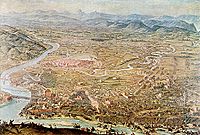
Victor Amadeus was surrounded by rulers from the Bourbon family, who were enemies of Philip V. He was forced to let French troops enter his lands to get Milan, which he wanted so much. He had to ally himself again with Louis XIV and his grandson in Spain. His daughter, Maria Luisa, was used to seal this alliance. She married Philip V in 1701. In 1701, Victor Amadeus fought bravely in the Battle of Chiari. This battle was fought for Bourbon control of Milan. By 1702, Victor Amadeus was thinking about switching sides again. He secretly wrote to the emperor, who promised him the Duchy of Montferrat. To keep him happy, the emperor offered more, adding lands in Lombardy.
In 1703, Victor Amadeus did switch sides. He joined the Grand Alliance, just like in the Nine Years War. Savoy struggled against the larger French forces. This led to a siege of Turin in 1706. Anne Marie's uncle, Louis XIV, along with Spanish forces, besieged Turin during the Battle of Turin. French troops were led by Anne Marie's half-brother, the Duke of Orléans. Anne Marie and her sons had to flee Turin for safety in Genoa. Turin was saved by the combined forces of Victor Amadeus and Prince Eugene of Savoy in September 1706.
Becoming King of Sicily and Sardinia
Because he helped in the War of the Spanish Succession, Victor Amadeus II gained the Kingdom of Sicily in 1713. This was part of the Treaty of Utrecht, which ended the war. He was crowned King of Sicily in Palermo on December 24, 1713. He returned to Turin in September 1714.
As the ruler of an independent kingdom, Victor Amadeus greatly expanded his foreign relations. Before, as a duke, he had envoys in France, the Empire, and Rome. In 1717, he created his own foreign office.
In 1720, Victor Amadeus was forced to trade Sicily for the less important Kingdom of Sardinia. This happened because an alliance of four nations, including some of his former allies, objected.
Giving Up the Throne and Later Years
Victor Amadeus had done a lot to improve his lands since 1684. In September 1730, he decided to give up his throne. The king was lonely and had lost most of his family. This included his favorite and eldest son, the Prince of Piedmont. He sought comfort with a former mistress, Anna Canalis di Cumiana. They married in a private ceremony on August 12, 1730, in Turin. They had permission from Pope Clement XII. Victor Amadeus had loved her for a long time. As a wedding gift, he made her the Marchioness of Spigno. The couple made their marriage public on September 3, 1730. A month later, Victor Amadeus announced he wanted to give up the throne. He did so in a ceremony at the Castle of Rivoli on his wedding day. His son, Charles Emmanuel III, became the new king.
Victor Amadeus took the title King Victor Amadeus. He and Anna moved to the château de Chambéry outside the capital. They had a small group of servants. Victor Amadeus was kept updated on state matters. He insisted on having a Louis XIV-style wig with him always, as his only luxury.
In 1731, after having a stroke, Victor Amadeus decided he wanted to be king again. He told his son about his decision. His son had him arrested. He was taken to the Castle of Moncalieri. Anna was sent back to her husband on April 12. The stroke seemed to have changed Victor Amadeus. He later became violent towards his wife, blaming her for his problems.
King Victor Amadeus died in September 1732. He was buried in the Convent of San Giuseppe di Carignano. His son decided not to bury him in the Basilica of Superga. Victor Amadeus had built this basilica and wanted to be buried there. But his son did not want to remind people of the scandal his father's abdication had caused. Anna was moved to a convent in Pinerolo, where she died at age 88.
Cultural Impact and Buildings
Victor Amadeus made many political changes. He also worked hard to make Savoy more important in Europe. But he also left a big cultural mark on his hometown. In 1697, Victor Amadeus asked André Le Nôtre to design large gardens at the Royal Palace of Turin. He had also asked the artist Daniel Seiter to paint a famous gallery there. This gallery still exists today. Victor Amadeus later made Seiter a knight. He also supported music in Savoy. His court became a place for many musicians of that time.
When he was crowned King of Sicily in Palermo in 1713, he brought back Filippo Juvarra to Turin. Juvarra was an Italian architect who had lived in Rome for many years. Victor Amadeus supported Juvarra's work. Juvarra was the architect behind the changes to the Royal Palace of Turin, the Palace of Venaria, and the Palazzina di caccia of Stupinigi. He also built the Basilica of Superga. The architect was also responsible for designing various roads and squares in Turin. Victor Amadeus's mother also used Juvarra to design the famous staircase inside the Palazzo Madama, where she lived after being sent away.
In 1997, UNESCO added a group of buildings connected to Victor Amadeus and his family to its World Heritage list. These buildings include the Royal Palace, the Palazzo Madama, the Palazzina di caccia of Stupinigi, and his wife's Villa della Regina. They are known as the Residences of the Royal House of Savoy.
Family and Children
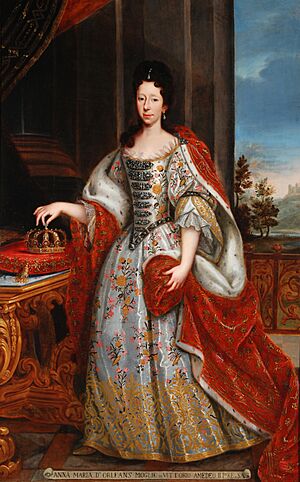
Victor Amadeus's relationship with his mother was always difficult. Some say it was because she wanted to keep power for herself. Marie Jeanne spent most of her time on state business. She enjoyed it and had little time for her only child. She watched him closely to make sure he would not try to take power. Anne Marie had six children with her husband. She also had two stillbirths, one in 1691 and another in 1697. Three of their children had their own children. This included the eldest, Maria Adelaide, who became the mother of Louis XV of France. His second daughter, Maria Luisa, married Philip V of Spain in 1701. She also served as regent of Spain at different times. These two marriages were strategies used by Louis XIV to keep Victor Amadeus close to France before the War of the Spanish Succession.
His favorite child was Victor Amadeus, born in 1699. He was given the title Prince of Piedmont as the future ruler. The Prince of Piedmont later died in 1715 from smallpox. Anne Marie died in 1728 after several heart attacks.
His relationship with his younger son and future successor, Charles Emmanuel, was not close. Victor Amadeus arranged Charles Emmanuel's first two marriages. The first was to Anne Christine of Sulzbach. They had a son who died as a baby. The second marriage was to Polyxena of Hesse-Rotenburg. She was a cousin of Anne Christine. She was the mother of six children, including the future Victor Amadeus III of Sardinia.
Legitimate Children
- Maria Adelaide of Savoy (1685–1712): She married Louis, Duke of Burgundy. He was the eldest son of Louis, Grand Dauphin. They had children, including Louis XV of France.
- Maria Anna of Savoy (1687–1690).
- Maria Luisa of Savoy (1688–1714): She married Philip V of Spain. He was the second son of Louis, Grand Dauphin. They had children, including two future kings of Spain.
- Victor Amadeus of Savoy (1699–1715): He died unmarried.
- Charles Emmanuel of Savoy (1701–1773): He became Duke of Savoy and later King of Sardinia.
- Emanuele Philibert of Savoy (1705–1705): He died as a baby.
Illegitimate Children
- Maria Vittoria of Savoy (1690–1766): She married Victor Amadeus I, Prince of Carignano and had children.
- Vittorio Francesco of Savoy (1694–1762): He married Maria Lucrezia Franchi di Pont but had no children.
See also
 In Spanish: Víctor Amadeo II de Saboya para niños
In Spanish: Víctor Amadeo II de Saboya para niños


